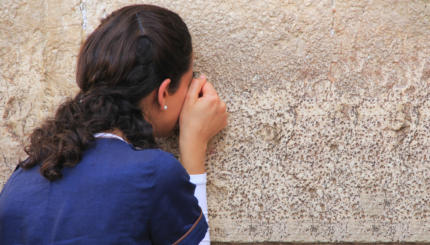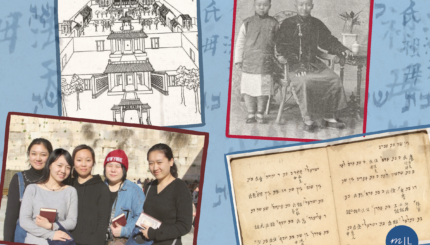In New York City, the hub of the Yiddish-American universe, over 150 Yiddish dailies, weeklies, monthlies, quarterlies, festival journals, and yearbooks appeared between 1885 and 1914. Some 20 dailies came into existence during that period, and for a time, at the turn of the century, as many as six competed simultaneously for readers.
Religion, Politics and Literature
The Tageblatt, founded in 1885, represented the Orthodox religious point of view. The Morgen Journal was also Orthodox and was the first (1901) truly successful Yiddish morning paper. The 1890s saw the beginning of the Forvarts (Jewish Daily Forward), a socialist paper, which, under the guiding hand of Abraham Cahan, became the largest Yiddish newspaper in the world. In the same decade the Freie Arbeiter Shtime was born, representing the anarchists. Even the weekly La America (1910-25), a Ladino paper for Sephardic readers, printed a Yiddish column to attract advertisers in the greater Eastern European community.
Almost all Yiddish periodicals carried literary pieces. Translated tales of adventure and romance, like The Count of Monte Cristo and Don Quixote, were very popular. Readers even took the time to struggle with translations from Turgenev, Tolstoy, and Zola, and to try to follow the original Yiddish work of I. L. Peretz and Mendele Mokher Sforim.
But “all could take instant delight in the homely tales of Sholom Aleichem” and feel the pathos of Morris Rosenfeld’s “sweatshop lyrics.” Zalman Libin’s portraits of life in the tenements and sweatshops and Jacob Gordin’s naturalistic sketches were featured in the more radical journals. Buttonhole maker David Edelstadt–who for a short time edited the Freie Arbeiter Shtime–and Morris Winchevsky, who published the first socialist pamphlets to appear in Yiddish, also wrote labor poems for the press and won a wide readership.

Help us keep Jewish knowledge accessible to millions of people around the world.
Your donation to My Jewish Learning fuels endless journeys of Jewish discovery. With your help, My Jewish Learning can continue to provide nonstop opportunities for learning, connection and growth.
A group of poets called Di yunge (the young ones)–Mani Lieb, Moishe Lieb Halpern, H. Leivick, and others–were linked for a time by their desire to write poetry that was not ideological. The majority of Di yunge were still shop workers, but they wanted to develop a freer, more personal poetry that would liberate them from what poet Zisha Landau called “the rhyme department of the labor movement.” And they, too, made their first appearances in the Yiddish press.
Whether politically conservative or radical, whether theologically Orthodox or secular, the Yiddish press was often sensationalist and extremist, lashing out at capitalism, socialism, Jewish institutions, or competing papers. Despite this tendency, all soon realized that something remarkable had developed. As Abe Cahan pointed out, “the five million Jews living under the czar had not a single Yiddish daily paper even when the government allowed such publication, while [Russian Jews] in America publish six dailies… countless Yiddish weeklies and monthlies, and [enough] books [to make] New York the largest Yiddish book market in the world.”
Jewish and American
Although it promoted a serious modern Yiddish literature, the press was also a powerfully effective agent of acculturation, nourishing the process of Americanization for the Jewish masses in their own language. Poems and stories dealing with the realities of America and the difficulties of adjustment helped the immigrants understand their new environment and to be less “green.” Yiddish newspapers focused on specifically Jewish problems, but editorially they frequently commented on purely American issues. They consistently emphasized the acquisition or development of “desirable” qualities and manners, “taught” American history and geography, and made untiring efforts in correcting civic “deficiencies” in their readers.
Even Abe Cahan’s Forward,which was dedicated to the propagation of socialism, was equally dedicated to Americanization. As early as 1903, Cahan advised immigrant parents to let Jewish “boys play baseball and become excellent at the game.” After all, he admonished, we ought not “raise the children to grow up foreigners in their own birthplace.”
Cahan was a moderate socialist, whose anti-capitalist views were tempered by American conditions. His paper, which excluded theoretical pieces and instead presented the class struggle in the form of stories and news from the marketplace, home, and factory, remained attractive to non-socialist Jews. At its height, the Forward published 12 metropolitan editions from Boston to Los Angeles, with a circulation of a half million (more than quarter million in New York City alone).
Community Empathy
The masses devoured the information and advice that the Forward and other papers gave them about life in America. One of the Forward’s best-read innovations was the bintl brief (bundle of letters), started in 1906. Letters from readers–often corrected and shortened by editors, and perhaps on slower days entirely concocted by them–were printed daily. It was a marvelous outlet for immigrants troubled by the tensions of a new life and an affirmation that their problems mattered.
They wrote about poverty and sickness, love and divorce, unemployment, intermarriage, conflicts of opinion, socialism, generational conflicts, declining religious observance, and just about everything else. The responses, written solely by Cahan in the early years, and later by his staff as well, tried to suggest that the immigrant should not make excessive demands on themselves, that they should even enjoy life a little bit. The editors did not advise immigrants to give up the religious or ideological preconceptions entirely, but they did encourage them to make the needs of everyday life primary.
Yiddish papers, as part of the Americanization process, also tried to acquaint their readers with English. Cahan, opening himself to the charge of corrupting the Yiddish language, encouraged his writers to follow the general custom of incorporating English words into their Yiddish articles. The Tageblatt went further; it began printing a full English page in 1897. These practices no doubt influenced ghetto conversation. By 1900 the immigrants were mingling an estimated 100 English words in their daily speech. Politzman, never mind, alle right, that’ll do, and other idioms slipped readily from the tongue.
At the same time that the Yiddish press acted as an Americanizing agent, it was, like the Yiddish theater, and the landsmanshaft [Jewish mutual aid society], and so many other Jewish immigrant institutions, an important part of the transitional, religiously based, ethnic culture of the Lower East Side. This culture, sustained by the largest, freest, and most heterogeneous Jewish community the world, became a Yiddish culture richer and greater than any achieved eastern Europe.
Sephardic
Pronounced: seh-FAR-dik, Origin: Hebrew, describing Jews descending from the Jews of Spain.

Help us keep Jewish knowledge accessible to millions of people around the world.
Your donation to My Jewish Learning fuels endless journeys of Jewish discovery. With your help, My Jewish Learning can continue to provide nonstop opportunities for learning, connection and growth.



